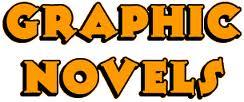 Graphic novels are one of the hot new genres today for young readers as well as teens. The popularity of the Manga and Anime imports from Japan started the interest in this comic book format and now biographies, histories, Shakespeare, and popular novels reformatted to the graphic novel versions have exploded onto the publishing scene. Teachers and librarians have learned more about the format and have made these new books and all the varieties and forms within the genre available to children and teens. The Children’s Literature and Reading Special Interest Group of IRA has taken a look at some of the newly published graphic novels this year and provided descriptions and teaching ideas to use in classrooms or to recommend for summer reading.
Graphic novels are one of the hot new genres today for young readers as well as teens. The popularity of the Manga and Anime imports from Japan started the interest in this comic book format and now biographies, histories, Shakespeare, and popular novels reformatted to the graphic novel versions have exploded onto the publishing scene. Teachers and librarians have learned more about the format and have made these new books and all the varieties and forms within the genre available to children and teens. The Children’s Literature and Reading Special Interest Group of IRA has taken a look at some of the newly published graphic novels this year and provided descriptions and teaching ideas to use in classrooms or to recommend for summer reading.
ReadWriteThink has several pages of lesson ideas to use with Graphic Novels from “An Introduction to Graphic Novels” to “Building Literacy Connections with Graphic Novels.”
The Engage blog also has lesson ideas and interviews relating to recent graphic novels:
GRADES K-3
May, Kyla. (2013). Lotus Lane: Coco: My delicious life. New York: Scholastic.
 Intended for early readers, this second title in the Lotus Lane series focuses on Coco whose interests are animals and cooking. While her friend Kiki is fascinated by fashion and style, Coco is more down to earth and disinterested in appearances. Along with her two friends, Kiki and Lulu, she has formed the Lotus Lane Girls Club, a small group that enables the girls to meet and work on projects or activities each week. When she learns about an endangered snail species from her father, Coco decides that the group should raise money to create a garden where snails can thrive. Naturally, the three friends end up combining two of Coco’s avocations, and they decide to bake cupcakes. But a silly superstition about black cats causes problems, and they almost miss the chance to get to know new girl Mika because of Lulu's uncertainty about her. Although the story itself is sweet and fairly predictable, readers will appreciate these girls’ interest in making the world a better place instead of more superficial pursuits. The images feature three friends who support each other’s interests while also feeling secure enough to celebrate their own uniqueness. Life can be delicious when you are true to yourself.
Intended for early readers, this second title in the Lotus Lane series focuses on Coco whose interests are animals and cooking. While her friend Kiki is fascinated by fashion and style, Coco is more down to earth and disinterested in appearances. Along with her two friends, Kiki and Lulu, she has formed the Lotus Lane Girls Club, a small group that enables the girls to meet and work on projects or activities each week. When she learns about an endangered snail species from her father, Coco decides that the group should raise money to create a garden where snails can thrive. Naturally, the three friends end up combining two of Coco’s avocations, and they decide to bake cupcakes. But a silly superstition about black cats causes problems, and they almost miss the chance to get to know new girl Mika because of Lulu's uncertainty about her. Although the story itself is sweet and fairly predictable, readers will appreciate these girls’ interest in making the world a better place instead of more superficial pursuits. The images feature three friends who support each other’s interests while also feeling secure enough to celebrate their own uniqueness. Life can be delicious when you are true to yourself.
- Barbara A. Ward, Washington State University Pullman
GRADES 3-5
Battle, Craig. (2013). Max Finder mystery: collected casebook Vol. 7. Illus. by Ramon Perez. Toronto, ON: Owlkids.
 This is the 7th volume in the Max Finder series that features ten mystery comics and two short stories. Each story involves a solve-it-yourself mystery where Max Finder and a few of his seventh-grade friends from Central Meadows Junior High find the answers to mysteries and solve cases around the school. Readers are invited to gather clues and pose questions to solve these mysteries for themselves. With a 21st century graphic novel format, this could be compared to the former Minute Mysteries or Solve It Yourself books that readers solve the problem. At the end of each short mystery a Solution page lists the clues and then offers the solution in a Conclusion paragraph. The cast of characters is presented in introductory pages with a picture and short text-box “twitter-style” description of each character. Kids who like to solve mysteries will enjoy this graphic series.
This is the 7th volume in the Max Finder series that features ten mystery comics and two short stories. Each story involves a solve-it-yourself mystery where Max Finder and a few of his seventh-grade friends from Central Meadows Junior High find the answers to mysteries and solve cases around the school. Readers are invited to gather clues and pose questions to solve these mysteries for themselves. With a 21st century graphic novel format, this could be compared to the former Minute Mysteries or Solve It Yourself books that readers solve the problem. At the end of each short mystery a Solution page lists the clues and then offers the solution in a Conclusion paragraph. The cast of characters is presented in introductory pages with a picture and short text-box “twitter-style” description of each character. Kids who like to solve mysteries will enjoy this graphic series.
- Karen Hildebrand, Ohio Library and Reading Consultant
Grine, Chris. (2013). ChickenHare. New York: Graphix/Scholastic Imprint.
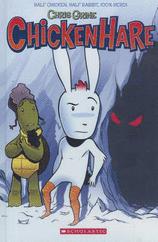 The quote on the cover of this book reads, “Half chicken, half rabbit, 100% Hero” and that does a great one-line job of describing this book. Hybrid species ChickenHare and his friend Abe, a box turtle with a beard, are trying to escape the clutches of the evil Mr. Klaus, a misguided taxidermist. In this fast-paced adventure, ChickenHare meets Banjo and Meg who are also evading Klaus as future projects for stuffing. While on the run they meet Mr. Buttons who is a goat ghost that is seeking revenge against Dr. Klaus. The subtle and sarcastic dialogue is humorous that older readers will understand and the cartoon-like illustrations of the strange hybrid cast of characters add to the humor of the offbeat and macabre humor of the adventure. Fans of Jeff Smith’s Bone series will enjoy this new series as a next read. Check out the Chicken Blog that talks about the book and includes a book trailer.
The quote on the cover of this book reads, “Half chicken, half rabbit, 100% Hero” and that does a great one-line job of describing this book. Hybrid species ChickenHare and his friend Abe, a box turtle with a beard, are trying to escape the clutches of the evil Mr. Klaus, a misguided taxidermist. In this fast-paced adventure, ChickenHare meets Banjo and Meg who are also evading Klaus as future projects for stuffing. While on the run they meet Mr. Buttons who is a goat ghost that is seeking revenge against Dr. Klaus. The subtle and sarcastic dialogue is humorous that older readers will understand and the cartoon-like illustrations of the strange hybrid cast of characters add to the humor of the offbeat and macabre humor of the adventure. Fans of Jeff Smith’s Bone series will enjoy this new series as a next read. Check out the Chicken Blog that talks about the book and includes a book trailer.
- Karen Hildebrand, Ohio Library and Reading Consultant
Holm, Jennifer L. and Matthew Holm. (2013). Extreme Babymouse. New York: Random House.
 The ever-popular and award-winning Babymouse is back, so grab your snowboards and get ready for the new volume and 17th adventure in the series. Babymouse’s trip to Snowy Mountain for her first snowboarding adventure begins with disappoint when she does not end up staying at the snazzy resort but at a rather shabby cabin that belongs to a school friend. She also discovers how much work and pain are involved in learning how to snowboard … and it looks so easy. Her instructor offers good advice when reminding Babymouse to go at her own pace, especially when Felicia Furrypaws dares her to attempt Half-Pipe Alley. Babymouse realizes her own beginning and limited skill at snowboarding, so when Felicia wipes out, Babymouse is pleased that she knew her own limitations. Surprise! The Lunch Lady makes a visit in this adventure as well. Check out the Babymouse website fun at the publisher’s website or even more background information at the author’s website.
The ever-popular and award-winning Babymouse is back, so grab your snowboards and get ready for the new volume and 17th adventure in the series. Babymouse’s trip to Snowy Mountain for her first snowboarding adventure begins with disappoint when she does not end up staying at the snazzy resort but at a rather shabby cabin that belongs to a school friend. She also discovers how much work and pain are involved in learning how to snowboard … and it looks so easy. Her instructor offers good advice when reminding Babymouse to go at her own pace, especially when Felicia Furrypaws dares her to attempt Half-Pipe Alley. Babymouse realizes her own beginning and limited skill at snowboarding, so when Felicia wipes out, Babymouse is pleased that she knew her own limitations. Surprise! The Lunch Lady makes a visit in this adventure as well. Check out the Babymouse website fun at the publisher’s website or even more background information at the author’s website.
- Karen Hildebrand, Ohio Library and Reading Consultant
Kipling, Rudyard. (2013). Rudyard Kipling’s Just So Comics; tales of the world’s wildest beasts. Illus. by Pedro Rodriguez. North Mankato, MN: Stone Arch Books/Capstone Publisher.
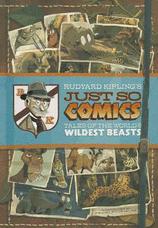 Certainly not the original stories of Kipling, but the colorful illustrations of Rodriguez make an interesting new approach to the Kipling stories of old, including: How the Leopard Got His Spots; How the Elephant Got His Trunk; How the Rhinoceros Got His Skin; and How the Camel Got His Hump. Starting with an illustrated comic-style map of the world, the locales and habitats of the animals to be read about are introduced. Kipling serves as the narrator as a new writing team (Sean Tulien, Blake A. Hoena, Martin Powell, and Louise Simonson) put a humorous spin on the dialogue to accompany the comic boxes of illustration for this adapted version of Kipling’s work. Each short story begins and ends with research about the animal depicted in the stories.
Certainly not the original stories of Kipling, but the colorful illustrations of Rodriguez make an interesting new approach to the Kipling stories of old, including: How the Leopard Got His Spots; How the Elephant Got His Trunk; How the Rhinoceros Got His Skin; and How the Camel Got His Hump. Starting with an illustrated comic-style map of the world, the locales and habitats of the animals to be read about are introduced. Kipling serves as the narrator as a new writing team (Sean Tulien, Blake A. Hoena, Martin Powell, and Louise Simonson) put a humorous spin on the dialogue to accompany the comic boxes of illustration for this adapted version of Kipling’s work. Each short story begins and ends with research about the animal depicted in the stories.
- Karen Hildebrand, Ohio Library and Reading Consultant
Lemke, Donnie (Ed.) (2012). Tall: Great American folktales. North Mankato, MN: Capstone/Stone Arch Books.
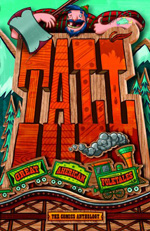 With their exaggeration and humor, tall tales can have high reader appeal since they contain enough credible material to be believed as well as elements that leave readers shaking their head in disbelief. This graphic version of four classic American tall tales serves up Paul Bunyan, Pecos Bill, John Henry, and Johnny Appleseed deliciously. A different author and illustrator team creates their version of the familiar stories. All four graphic versions of the folktales have been published previously and then collected for this volume. From Paul's devotion to his faithful companion Babe the Blue Ox to Bill's larger-than-life stance, and further from Johnny's focus on the simple pleasures in life to John's heart of gold, strong work ethic, and determination to defeat the machine pitted against him, each of these larger-than-life men provides a good example for readers of how important attitudes toward others may be. There are plenty of humorous moments and several scenes that provide explanations for changes in the environment; for instance, readers can choose to credit (or blame) Paul or Bill for the Grand Canyon, that great rift in the Earth’s surface. Most appealingly, each story is followed by brief back matter that provides background on the legends and their real life counterparts or extends the story in some interesting way. This title will certainly spark interest in more folktales and might even prompt some budding writers to create their own. Readers will enjoy how the stories stand alone with unique interpretations, partly derived from how they are told but also from their illustrations.
With their exaggeration and humor, tall tales can have high reader appeal since they contain enough credible material to be believed as well as elements that leave readers shaking their head in disbelief. This graphic version of four classic American tall tales serves up Paul Bunyan, Pecos Bill, John Henry, and Johnny Appleseed deliciously. A different author and illustrator team creates their version of the familiar stories. All four graphic versions of the folktales have been published previously and then collected for this volume. From Paul's devotion to his faithful companion Babe the Blue Ox to Bill's larger-than-life stance, and further from Johnny's focus on the simple pleasures in life to John's heart of gold, strong work ethic, and determination to defeat the machine pitted against him, each of these larger-than-life men provides a good example for readers of how important attitudes toward others may be. There are plenty of humorous moments and several scenes that provide explanations for changes in the environment; for instance, readers can choose to credit (or blame) Paul or Bill for the Grand Canyon, that great rift in the Earth’s surface. Most appealingly, each story is followed by brief back matter that provides background on the legends and their real life counterparts or extends the story in some interesting way. This title will certainly spark interest in more folktales and might even prompt some budding writers to create their own. Readers will enjoy how the stories stand alone with unique interpretations, partly derived from how they are told but also from their illustrations.
- Barbara A. Ward, Washington State University Pullman
Lieberman, AJ. (2013). The Silver Six. Illus. by Darren Rawlings. New York: Scholastic/Graphix.
 Readers interested in science fiction, orphans, and villains as well as relationships among comrades will thoroughly enjoy this graphic novel set in a dismal future where Earth's citizens live inside bubbles while relying on Hydro-2 for their energy needs. Hydro-2 is controlled by greedy Craven Mining, a company that exploits Earth's natural resources in order to enrich its own coffers. When several scientists and researchers come close to finding an alternative fuel source, they are killed. The daughter of two of those scientists, Phoebe Hemingway has been living alone with her robot Max ever since their deaths. She keeps the landlord at bay with recordings of her parents’ voices played in the background. When she ends up in an orphanage while running for her life from an assassin, the man who runs the Craven Mining group will stop at nothing to find out what she knows about her parents' work. He suspects that they sent her a message about their work, and releasing that information to the general public could be disastrous for him. Luckily for Phoebe, she makes five friends in the orphanage, Hannah, Becca, Ian, Patel, and Oliver. Oliver is slow to warm to Phoebe since he mistrusts just about everyone, but the six realize that they have something in common. Their shared connections prompt them to escape the work teams to which they’ve been assigned and the boring classroom lectures where teachers dole out incorrect versions of history. The super-smart youngsters travel to an uninhabited moon with promising clues that may help them figure out why Craven is so desperate to get his hands on Phoebe. The story is engaging, and the illustrations have eye appeal. Although it might be unlikely that these six children could be so smart and so scientifically advanced, it's still fun to watch them solve problems and conquer their own fears while bonding with others.
Readers interested in science fiction, orphans, and villains as well as relationships among comrades will thoroughly enjoy this graphic novel set in a dismal future where Earth's citizens live inside bubbles while relying on Hydro-2 for their energy needs. Hydro-2 is controlled by greedy Craven Mining, a company that exploits Earth's natural resources in order to enrich its own coffers. When several scientists and researchers come close to finding an alternative fuel source, they are killed. The daughter of two of those scientists, Phoebe Hemingway has been living alone with her robot Max ever since their deaths. She keeps the landlord at bay with recordings of her parents’ voices played in the background. When she ends up in an orphanage while running for her life from an assassin, the man who runs the Craven Mining group will stop at nothing to find out what she knows about her parents' work. He suspects that they sent her a message about their work, and releasing that information to the general public could be disastrous for him. Luckily for Phoebe, she makes five friends in the orphanage, Hannah, Becca, Ian, Patel, and Oliver. Oliver is slow to warm to Phoebe since he mistrusts just about everyone, but the six realize that they have something in common. Their shared connections prompt them to escape the work teams to which they’ve been assigned and the boring classroom lectures where teachers dole out incorrect versions of history. The super-smart youngsters travel to an uninhabited moon with promising clues that may help them figure out why Craven is so desperate to get his hands on Phoebe. The story is engaging, and the illustrations have eye appeal. Although it might be unlikely that these six children could be so smart and so scientifically advanced, it's still fun to watch them solve problems and conquer their own fears while bonding with others.
- Barbara A. Ward, Washington State University Pullman
Phelan, Matt. (2013). Bluffton. Somerville, MA: Candlewick Press.
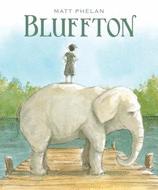 Scott O’Dell Award-winning author (The Storm in the Barn) Matt Phelan brings another historically significant era to the graphic novel format. The star of his new book is Buster Keaton. It opens in the town of Muskegon, Michigan, in 1908 when young Henry Harrison learns that a troupe of vaudeville performers are spending the summer in the small town of Bluffton, just outside of Muskegon. Henry is enthralled with the idea of performing and is in awe of the actors. When he happens to meet young Buster when Buster and his brothers and sisters tumble out of a window, Henry begins a friendship that places him in baseball games, fishing antics, and more trouble and fun than he ever imagined. Buster’s fame is growing and his nickname “the human mop” comes from the fact he can do the most amazing slapstick routines as his body bends and twists and tumbles in all directions. Bring in Phelan’s soft watercolor illustrations, inspired by Winslow Homer and Carl Larsson, shining in the summer sun and warmth of budding friendships come to life. A book trailer is available on YouTube or read more about the graphic artist and his work at My3Books. Teachers might also like to download this Q & A with creator Matt Phelan for more background information.
Scott O’Dell Award-winning author (The Storm in the Barn) Matt Phelan brings another historically significant era to the graphic novel format. The star of his new book is Buster Keaton. It opens in the town of Muskegon, Michigan, in 1908 when young Henry Harrison learns that a troupe of vaudeville performers are spending the summer in the small town of Bluffton, just outside of Muskegon. Henry is enthralled with the idea of performing and is in awe of the actors. When he happens to meet young Buster when Buster and his brothers and sisters tumble out of a window, Henry begins a friendship that places him in baseball games, fishing antics, and more trouble and fun than he ever imagined. Buster’s fame is growing and his nickname “the human mop” comes from the fact he can do the most amazing slapstick routines as his body bends and twists and tumbles in all directions. Bring in Phelan’s soft watercolor illustrations, inspired by Winslow Homer and Carl Larsson, shining in the summer sun and warmth of budding friendships come to life. A book trailer is available on YouTube or read more about the graphic artist and his work at My3Books. Teachers might also like to download this Q & A with creator Matt Phelan for more background information.
- Karen Hildebrand, Ohio Library and Reading Consultant
Pierce, Lincoln. (2013). Big Nate: Genius Mode. New York, NY: Harper Collins.
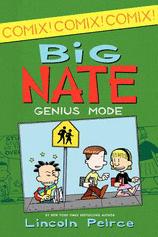 In this comical graphic novel, readers meet Big Nate, who figures out the perfect formula for becoming a genius. He decides not to study during his sixth grade and save his brain instead. The book covers the entire academic year, from the start of the year to the summer vacation. To his credit, Big Nate tries several new things: giving a Valentine cookie to a girl, trying to teach Spisty (his pet dog) new tricks, and being a caddy when his dad plays golf, but something unexpected always happens. The cookie gets sent to Gina instead of Tina. Spitsy is friendlier with cats than with humans. And his dad turns out to be terrible at playing golf. Despite getting Cs in his classes, Big Nate remains perfectly content with his life until his father realizes he is making low grades in the report card, which then leads him to even more adventures. The voice of a reluctant sixth grade reader is portrayed perfectly. The struggle between turning geeky and remaining cool, the interest in girls (except Gina) and hanging out with friends, asking Mr. Rosa to mentor the kids, and the consequences of Nate's actions are all detailed admirably using both pictures and words. More Big Nate fun can be found at his very own website: Big Nate.
In this comical graphic novel, readers meet Big Nate, who figures out the perfect formula for becoming a genius. He decides not to study during his sixth grade and save his brain instead. The book covers the entire academic year, from the start of the year to the summer vacation. To his credit, Big Nate tries several new things: giving a Valentine cookie to a girl, trying to teach Spisty (his pet dog) new tricks, and being a caddy when his dad plays golf, but something unexpected always happens. The cookie gets sent to Gina instead of Tina. Spitsy is friendlier with cats than with humans. And his dad turns out to be terrible at playing golf. Despite getting Cs in his classes, Big Nate remains perfectly content with his life until his father realizes he is making low grades in the report card, which then leads him to even more adventures. The voice of a reluctant sixth grade reader is portrayed perfectly. The struggle between turning geeky and remaining cool, the interest in girls (except Gina) and hanging out with friends, asking Mr. Rosa to mentor the kids, and the consequences of Nate's actions are all detailed admirably using both pictures and words. More Big Nate fun can be found at his very own website: Big Nate.
- Rani Iyer, Washington State University Pullman
Shapiro, David. (2013). Terra Tempo; The Four Corners of Time. Illus. by Christopher Herndon; Color by Erica Melville. Portland, OR: Craigmore Creations.
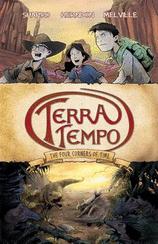 Everyone loves a good time travel back to the age of the dinosaurs and this new volume in the Terra Tempo series does just that. Jenna, Caleb, and Ari have returned after their adventure in Ice Age Cataclysm! This time, Ari finds the Time Map of the Colorado Plateau in the Grand Canyon of Arizona, but there are other not-so-righteous folks who want the map for themselves. Battling dinosaurs and giant fish, in addition to the bad guys, the fearless trio find themselves back in time over 500 million years ago. Author David Shapiro has a degree in natural history and so has created a story that involves the flora and fauna and geology and zoology of this time travel, and the illustrators have brought these landscapes to life through graphic novel panels. Teachers will find lesson plan and extension ideas at the publisher’s website or keep up with these Time Travelers at their website, Terra Tempo.
Everyone loves a good time travel back to the age of the dinosaurs and this new volume in the Terra Tempo series does just that. Jenna, Caleb, and Ari have returned after their adventure in Ice Age Cataclysm! This time, Ari finds the Time Map of the Colorado Plateau in the Grand Canyon of Arizona, but there are other not-so-righteous folks who want the map for themselves. Battling dinosaurs and giant fish, in addition to the bad guys, the fearless trio find themselves back in time over 500 million years ago. Author David Shapiro has a degree in natural history and so has created a story that involves the flora and fauna and geology and zoology of this time travel, and the illustrators have brought these landscapes to life through graphic novel panels. Teachers will find lesson plan and extension ideas at the publisher’s website or keep up with these Time Travelers at their website, Terra Tempo.
- Karen Hildebrand, Ohio Library and Reading Consultant
Tan, Shaun. (2013). The Bird King: An artist’s notebook. New York: Scholastic/Arthur A. Levine.
 Readers of all ages were captivated by this imaginative artist’s creations and imagination in The Arrival (2007), Tales from Outer Suburbia (2009), and Lost & Found (2011), all surreal versions of the world around us. This marvelous artist’s sketchbook allows readers to peek into the mind and creative process of this unique man as they see where his ideas begin, how he sets them down on paper, and then makes revisions. There are examples of illustrations with promising starts that end up going nowhere and interesting artistic blending between reality and fantasy as the artist envisions creatures, part reality-based and part imagination, not found in everyday life. Providing even more insight into how one artist works, this notebook contains brief introductory comments to the different sections—Untold Stories; Book, Theater, and Film; Drawings from Life; Notebooks; Endpapers—from the artist himself. Budding artists will be relieved to learn that even this accomplished artist has plenty of ideas that never pan out or look the way he thought they would. Fans of Tan's work will be delighted to recognize some of the artwork contained in his other books and note images that seem to fascinate him. This is one to savor and from which to gain insight into one man's vision of the world. To learn even more and for helpful classroom connections, teachers will want to check out this helpful website.
Readers of all ages were captivated by this imaginative artist’s creations and imagination in The Arrival (2007), Tales from Outer Suburbia (2009), and Lost & Found (2011), all surreal versions of the world around us. This marvelous artist’s sketchbook allows readers to peek into the mind and creative process of this unique man as they see where his ideas begin, how he sets them down on paper, and then makes revisions. There are examples of illustrations with promising starts that end up going nowhere and interesting artistic blending between reality and fantasy as the artist envisions creatures, part reality-based and part imagination, not found in everyday life. Providing even more insight into how one artist works, this notebook contains brief introductory comments to the different sections—Untold Stories; Book, Theater, and Film; Drawings from Life; Notebooks; Endpapers—from the artist himself. Budding artists will be relieved to learn that even this accomplished artist has plenty of ideas that never pan out or look the way he thought they would. Fans of Tan's work will be delighted to recognize some of the artwork contained in his other books and note images that seem to fascinate him. This is one to savor and from which to gain insight into one man's vision of the world. To learn even more and for helpful classroom connections, teachers will want to check out this helpful website.
- Barbara A. Ward, Washington State University Pullman
TenNapel, Doug. (2013). Tommysaurus Rex. New York: Graphix/ Scholastic Imprint.
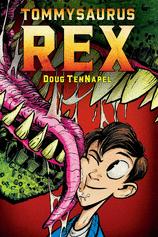 Young Ely and his dog Tommy are best friends, though Tommy gets into mischief a great deal of the time. When Tommy is hit and killed by a truck, Ely is devastated. His parents decide he should go to his grandfather’s farm for the summer to get his mind off the death of his pet. His grandfather puts him to work pulling weeds until he drops from exhaustion. While on the farm, he meets a few other young boys who turn out to be bullies and pick on Ely and play pranks on him. They bullies, led by Randy, chase after Ely when he runs away and thinks he as escaped into a cave. Randy and his crew find Ely in the cave and shove dog doo in his mouth. Seeing Ely’s dinosaur model on a nearby rock they steal his toy T-Rex and leave Ely in misery. Ely can’t understand why these boys would treat him this way. Later, Ely returns to the cave to investigate strange sounds he had heard earlier. Cracking through the rock, an enormous Tyrannosaurus Rex breaks through and befriends Ely. Now the real trouble begins as Ely tries to explain and defend the presence of a T-Rex to the community. He tries to train and work with his new “pet” and becomes somewhat convinced that it is his dog, Tommy, come back to him in the form of a new pet … a dinosaur. Several themes run through this graphic novel as friendships, pets, and bullies are explored. Visit the author’s website to learn more about his interesting background.
Young Ely and his dog Tommy are best friends, though Tommy gets into mischief a great deal of the time. When Tommy is hit and killed by a truck, Ely is devastated. His parents decide he should go to his grandfather’s farm for the summer to get his mind off the death of his pet. His grandfather puts him to work pulling weeds until he drops from exhaustion. While on the farm, he meets a few other young boys who turn out to be bullies and pick on Ely and play pranks on him. They bullies, led by Randy, chase after Ely when he runs away and thinks he as escaped into a cave. Randy and his crew find Ely in the cave and shove dog doo in his mouth. Seeing Ely’s dinosaur model on a nearby rock they steal his toy T-Rex and leave Ely in misery. Ely can’t understand why these boys would treat him this way. Later, Ely returns to the cave to investigate strange sounds he had heard earlier. Cracking through the rock, an enormous Tyrannosaurus Rex breaks through and befriends Ely. Now the real trouble begins as Ely tries to explain and defend the presence of a T-Rex to the community. He tries to train and work with his new “pet” and becomes somewhat convinced that it is his dog, Tommy, come back to him in the form of a new pet … a dinosaur. Several themes run through this graphic novel as friendships, pets, and bullies are explored. Visit the author’s website to learn more about his interesting background.
- Karen Hildebrand, Ohio Library and Reading Consultant
GRADES 5-8
Halliday, Ayun. (2013). Peanut. Illus. by Paul Hoppe. New York: Schwartz & Wade Books.
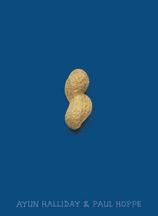 As Sadie Wildhack enters her sophomore year in a new high school, she is looking for a way to reinvent herself as she has been an invisible entity in her last eight moves from school to school. She decides upon a peanut allergy and tells all her new friends about the severe reactions she gets when around peanut products. As her new classmates listen and hear about her “condition” she gains sympathetic friends and even a possible boyfriend. She even sends away for a medic alert bracelet to add credibility to her fabrication. However, like most lies, she gets caught in her own trap. Themes about types of friendships, peer pressure, new schools, a little romance, and the obvious consequences of lying abound. The artwork is well done and it is easy to follow Sadie’s character as she is always in red. Read more about this book and other peanut information at the author’s website.
As Sadie Wildhack enters her sophomore year in a new high school, she is looking for a way to reinvent herself as she has been an invisible entity in her last eight moves from school to school. She decides upon a peanut allergy and tells all her new friends about the severe reactions she gets when around peanut products. As her new classmates listen and hear about her “condition” she gains sympathetic friends and even a possible boyfriend. She even sends away for a medic alert bracelet to add credibility to her fabrication. However, like most lies, she gets caught in her own trap. Themes about types of friendships, peer pressure, new schools, a little romance, and the obvious consequences of lying abound. The artwork is well done and it is easy to follow Sadie’s character as she is always in red. Read more about this book and other peanut information at the author’s website.
- Karen Hildebrand, Ohio Library and Reading Consultant
McKay, Sharon E. (2013). War brothers: The graphic novel. Illus. by Daniel LaFrance. Toronto, ON: Annick Press.
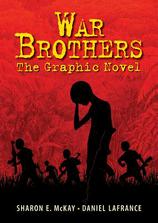 Based on a previously published novel, which was, in turn, based on the real-life experiences of boys from Gulu, Uganda, this graphic novel tells the story of the boy soldiers conscripted into Joseph Kony's Lord's Resistance Army. It starts off casually enough as Jacob and his friends are excited to begin school at George Jones Seminary for Boys, but there is an ominous undertone referring to violence in the country. The new term has barely begun when the boys and their other classmates are kidnapped, tortured, and forced to participate in various atrocities. Jacob loves math, and like the others, has led a sheltered life. Although he has been aware of violence, he has never been touched directly by it until now. As he watches his friend Tony, who planned to become a priest, beat another classmate to death, he prays desperately for rescue by the government's military forces or his father. The leader of the rebels insists that no one eats unless he works, but the kind of work he requires is unthinkable for Jacob. When rescue never comes, Jacob and his friends escape with Hannah, a girl whose ears have been hacked off because she tried to escape once before. This story is powerful, moving, and prompts much introspection about humans' inhumanity to others, boy soldiers, and how quickly an individual may be persuaded to kill another or betray others in order to save his/her own life. It also contains a powerful message about the redemptive power of hope and the resilience of individuals such as Jacob. The graphic novel format makes a compelling, heart-breaking story even more compelling. Understandably, readers will find it hard to forget this story, Jacob or his slow recovery from his ordeal.
Based on a previously published novel, which was, in turn, based on the real-life experiences of boys from Gulu, Uganda, this graphic novel tells the story of the boy soldiers conscripted into Joseph Kony's Lord's Resistance Army. It starts off casually enough as Jacob and his friends are excited to begin school at George Jones Seminary for Boys, but there is an ominous undertone referring to violence in the country. The new term has barely begun when the boys and their other classmates are kidnapped, tortured, and forced to participate in various atrocities. Jacob loves math, and like the others, has led a sheltered life. Although he has been aware of violence, he has never been touched directly by it until now. As he watches his friend Tony, who planned to become a priest, beat another classmate to death, he prays desperately for rescue by the government's military forces or his father. The leader of the rebels insists that no one eats unless he works, but the kind of work he requires is unthinkable for Jacob. When rescue never comes, Jacob and his friends escape with Hannah, a girl whose ears have been hacked off because she tried to escape once before. This story is powerful, moving, and prompts much introspection about humans' inhumanity to others, boy soldiers, and how quickly an individual may be persuaded to kill another or betray others in order to save his/her own life. It also contains a powerful message about the redemptive power of hope and the resilience of individuals such as Jacob. The graphic novel format makes a compelling, heart-breaking story even more compelling. Understandably, readers will find it hard to forget this story, Jacob or his slow recovery from his ordeal.
- Barbara A. Ward, Washington State University Pullman
GRADES 9-12
Yolen, Jane. (2013). Curses! Foiled again. Illus. by Mike Cavallaro. First Second Books.
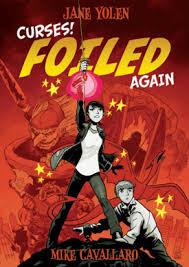 Aliera Carstairs is back from her first adventure in Foiled (2010) and is again swashbuckling her way into new adventures. As the Defender of the Faerie, Aliera continues her fencing lessons, and in fact, hopes to compete in the Nationals competition. Just when she is balancing high school and fencing practice, her cousin, Caroline, is kidnapped. With the help of her sidekick Avery, high school hottie by day and troll by night, they set out to find Caroline. Cavallaro’s use of color is intriguing as the action takes readers to and from the faerie world through the eyes of humans. Each chapter name is a fencing movement or technique beginning with Engagement and on to Invito, Point in Line, and more until the final chapter, Disengagement. Yolen weaves many fairy tale references through the story line and includes a few surprises and twists along the way. The final page ends with, “And it’s not over yet” leaving readers dangling for the next installment. Enjoy an interview with author Jane Yolen with School Library Journal.
Aliera Carstairs is back from her first adventure in Foiled (2010) and is again swashbuckling her way into new adventures. As the Defender of the Faerie, Aliera continues her fencing lessons, and in fact, hopes to compete in the Nationals competition. Just when she is balancing high school and fencing practice, her cousin, Caroline, is kidnapped. With the help of her sidekick Avery, high school hottie by day and troll by night, they set out to find Caroline. Cavallaro’s use of color is intriguing as the action takes readers to and from the faerie world through the eyes of humans. Each chapter name is a fencing movement or technique beginning with Engagement and on to Invito, Point in Line, and more until the final chapter, Disengagement. Yolen weaves many fairy tale references through the story line and includes a few surprises and twists along the way. The final page ends with, “And it’s not over yet” leaving readers dangling for the next installment. Enjoy an interview with author Jane Yolen with School Library Journal.
- Karen Hildebrand, Ohio Library and Reading Consultant
ADULT/PROFESSIONAL
Monnin, Katie. (2013). Teaching reading comprehension with graphic texts: An illustrated adventure. Illus. by Rachel Bowman. North Mankato, MN: Capstone/Maupin House.
 Appropriately, this primer on how to read and teach graphic texts in today's classroom relies on text and illustrations to make its points. By first detailing the evolution of the author, Katie, as she sampled graphic texts, and then following her emerging ideas as they play out in the classroom, the book engages readers and provides support teachers as they integrate multi-modal texts in their own classrooms. Divided into two parts and six chapters focusing on the importance of graphic texts in literacy as well as providing specific lesson for how to teach them, the book is filled with excellent information about the different features of these texts such as thought balloons and gutters as well as humor. Readers will enjoy the section devoted to the meeting of the League of Extraordinary Graphic Novel Gurus featuring Dr. James Bucky Carter, Jeff Smith, Scott McCloud, Will Eisner, Art Spiegelman, Marjane Satrapi, and Harvey Pekar, all influential experts in this area and either creators or researchers of graphic novels. Most appealing of all, though, may be the author’s own admonition of her initial disdain for this type of reading, the interaction between the author and the illustrator, and the sections inviting readers to record their own thoughts on what they have read. Mind-expanding and edgy, this is a terrific book to generate possible curricular and methodological changes.
Appropriately, this primer on how to read and teach graphic texts in today's classroom relies on text and illustrations to make its points. By first detailing the evolution of the author, Katie, as she sampled graphic texts, and then following her emerging ideas as they play out in the classroom, the book engages readers and provides support teachers as they integrate multi-modal texts in their own classrooms. Divided into two parts and six chapters focusing on the importance of graphic texts in literacy as well as providing specific lesson for how to teach them, the book is filled with excellent information about the different features of these texts such as thought balloons and gutters as well as humor. Readers will enjoy the section devoted to the meeting of the League of Extraordinary Graphic Novel Gurus featuring Dr. James Bucky Carter, Jeff Smith, Scott McCloud, Will Eisner, Art Spiegelman, Marjane Satrapi, and Harvey Pekar, all influential experts in this area and either creators or researchers of graphic novels. Most appealing of all, though, may be the author’s own admonition of her initial disdain for this type of reading, the interaction between the author and the illustrator, and the sections inviting readers to record their own thoughts on what they have read. Mind-expanding and edgy, this is a terrific book to generate possible curricular and methodological changes.
- Barbara A. Ward, Washington State University Pullman
These reviews are submitted by members of the International Reading Association's Children's Literature and Reading Special Interest Group (CL/R SIG) and are published weekly on Reading Today Online. The International Reading Association partners with the National Council of Teachers of English and Verizon Thinkfinity to produce ReadWriteThink.org, a website devoted to providing literacy instruction and interactive resources for grades K–12.